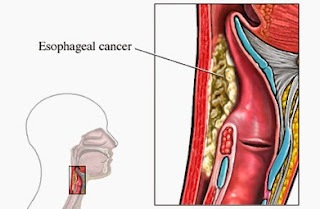What Is Esophageal Cancer?
Esophagus is also known as Food-pipe, it is the tube that carries food, liquids and saliva from your mouth to the stomach. Esophageal Cancer is the uncontrolled growth of abnormal cells in or on the food-pipe. If left untreated, these Cancerous cells spread very rapidly to the nearby tissues and other parts of the body and overall affects to the consumption of food and other related complications.
The symptoms of esophageal cancer are given below.
Esophageal cancer treatment:-
Following are some of the esophageal cancer treatment options
Radiotherapy: High-energy radiation beams are targeted on the cancerous tissue in order to destroy it. Radiotherapy is usually used in addition with either chemotherapy or surgery.
Surgery: The surgical procedure for removing the entire or a part of the esophagus depends on the location and size of the tumor. There are a number of surgical procedures for reaching to the esophagus. The surgical procedure can remove nearby soft tissues, a section of the esophagus and the lymph nodes. The entire or a part of the stomach can also be removed. The cancer is removed by making several incisions in the abdomen and chest. In majority of cases, the stomach is pulled up and is then joined with the remaining portion of the esophagus. Also, a part of the intestine is used for connecting the stomach with the esophagus remaining part. A part of large intestine or small intestine may also be used. A part of the intestine is used when the stomach is removed for joining it with the left over part of the esophagus to the small intestine.
Chemotherapy: People with esophageal cancer can also be treated with the help of chemotherapy. This therapy makes use of certain drugs that helps in destroying the cancer cells. The injection of these drugs is done into a vein (intravenous) that then travels throughout the different parts of the body.
Esophagus is also known as Food-pipe, it is the tube that carries food, liquids and saliva from your mouth to the stomach. Esophageal Cancer is the uncontrolled growth of abnormal cells in or on the food-pipe. If left untreated, these Cancerous cells spread very rapidly to the nearby tissues and other parts of the body and overall affects to the consumption of food and other related complications.
The symptoms of esophageal cancer are given below.
- Chest pain, pressure or burning
- Worsening indigestion or heartburn.
- Frequent choking while eating
- Coughing or hoarseness of voice
- Hoarseness or coughing
- Difficulty swallowing (Dysphagia)
- Weight loss without trying.
- Fatigue
- Smoking, chewing Tobacco
- Drinking very hot drinks for many years
- Drinking Alcohol
- Poor diet
Esophageal cancer treatment:-
Following are some of the esophageal cancer treatment options
Radiotherapy: High-energy radiation beams are targeted on the cancerous tissue in order to destroy it. Radiotherapy is usually used in addition with either chemotherapy or surgery.
Surgery: The surgical procedure for removing the entire or a part of the esophagus depends on the location and size of the tumor. There are a number of surgical procedures for reaching to the esophagus. The surgical procedure can remove nearby soft tissues, a section of the esophagus and the lymph nodes. The entire or a part of the stomach can also be removed. The cancer is removed by making several incisions in the abdomen and chest. In majority of cases, the stomach is pulled up and is then joined with the remaining portion of the esophagus. Also, a part of the intestine is used for connecting the stomach with the esophagus remaining part. A part of large intestine or small intestine may also be used. A part of the intestine is used when the stomach is removed for joining it with the left over part of the esophagus to the small intestine.
Chemotherapy: People with esophageal cancer can also be treated with the help of chemotherapy. This therapy makes use of certain drugs that helps in destroying the cancer cells. The injection of these drugs is done into a vein (intravenous) that then travels throughout the different parts of the body.













0 comments:
Post a Comment